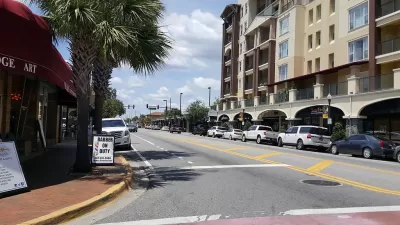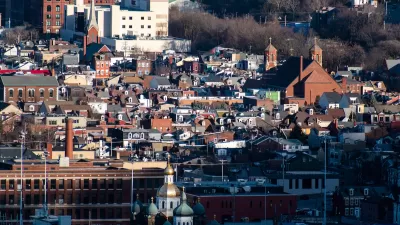New research shows that reducing wasteful use of street space and eliminating overly wide streets would increase opportunities for housing development and higher density.

A report in the Journal of the American Planning Association claims that the excessive width of many U.S. streets constrains the potential for increased population density. According to the report, "street design manuals ignore the fact that the more valuable the land, the narrower the road should be." Street design undervalues street space, writes Jean Dimeo, "whereas residential and commercial rents and sale prices make many metropolitan regions increasingly unaffordable." Minimum street widths, like minimum parking requirements, cripple a city's ability to develop more housing and increase density. "In the most expensive county in the data set—Santa Clara (CA)—narrowing the right-of-way to 16 ft would save more than $100,000 per housing unit through reduced land consumption."
Report author Adam Millard-Ball, an associate professor of urban planning at the University of California, Los Angeles, outlines suggestions for reducing wasteful use of street space and making room for more housing. These include reducing some low-volume roadways to "'yield streets,' with a single bidirectional lane and passing places," eliminating street-width requirements, and selling excessive right-of-way to developers. "Rather than requiring a land owner to provide a portion of the property for the street, a city could increase inclusionary housing requirements, require some land to be protected as natural habitat, or levy impact fees for contributions to parks, specialized firefighting equipment and public services."
FULL STORY: Want More Affordable Housing? Try Building Narrower Streets

Alabama: Trump Terminates Settlements for Black Communities Harmed By Raw Sewage
Trump deemed the landmark civil rights agreement “illegal DEI and environmental justice policy.”

Planetizen Federal Action Tracker
A weekly monitor of how Trump’s orders and actions are impacting planners and planning in America.

Why Should We Subsidize Public Transportation?
Many public transit agencies face financial stress due to rising costs, declining fare revenue, and declining subsidies. Transit advocates must provide a strong business case for increasing public transit funding.

Understanding Road Diets
An explainer from Momentum highlights the advantages of reducing vehicle lanes in favor of more bike, transit, and pedestrian infrastructure.

New California Law Regulates Warehouse Pollution
A new law tightens building and emissions regulations for large distribution warehouses to mitigate air pollution and traffic in surrounding communities.

Phoenix Announces Opening Date for Light Rail Extension
The South Central extension will connect South Phoenix to downtown and other major hubs starting on June 7.
Urban Design for Planners 1: Software Tools
This six-course series explores essential urban design concepts using open source software and equips planners with the tools they need to participate fully in the urban design process.
Planning for Universal Design
Learn the tools for implementing Universal Design in planning regulations.
Caltrans
Smith Gee Studio
Institute for Housing and Urban Development Studies (IHS)
City of Grandview
Harvard GSD Executive Education
Toledo-Lucas County Plan Commissions
Salt Lake City
NYU Wagner Graduate School of Public Service





























